The legacy of Roman engineering continues to astonish us, centuries after the fall of the empire. Among their remarkable innovations, Roman aqueducts stand as a testament to their ingenuity, precision, and understanding of the natural world. These architectural marvels not only provided water to the sprawling Roman cities but also showcased the advanced engineering concepts of the time.
Key Takeaways
- Roman aqueducts were masterful feats of engineering that utilized a gravity-driven system for water transportation, ensuring efficient water flow through a network of stone, brick, concrete, and lead conduits.
- The Romans prioritized public water needs with free access to potable water through a well-organized supply and distribution system, relying on springs, rivers, and wells while ensuring proper water management and sanitation.
- Despite their impressive design and significance in Roman society, the aqueducts declined post the fall of the Western Roman Empire due to lack of maintenance and were later revitalized during the Renaissance, inspiring modern water distribution systems.
The Genius of Roman Aqueducts
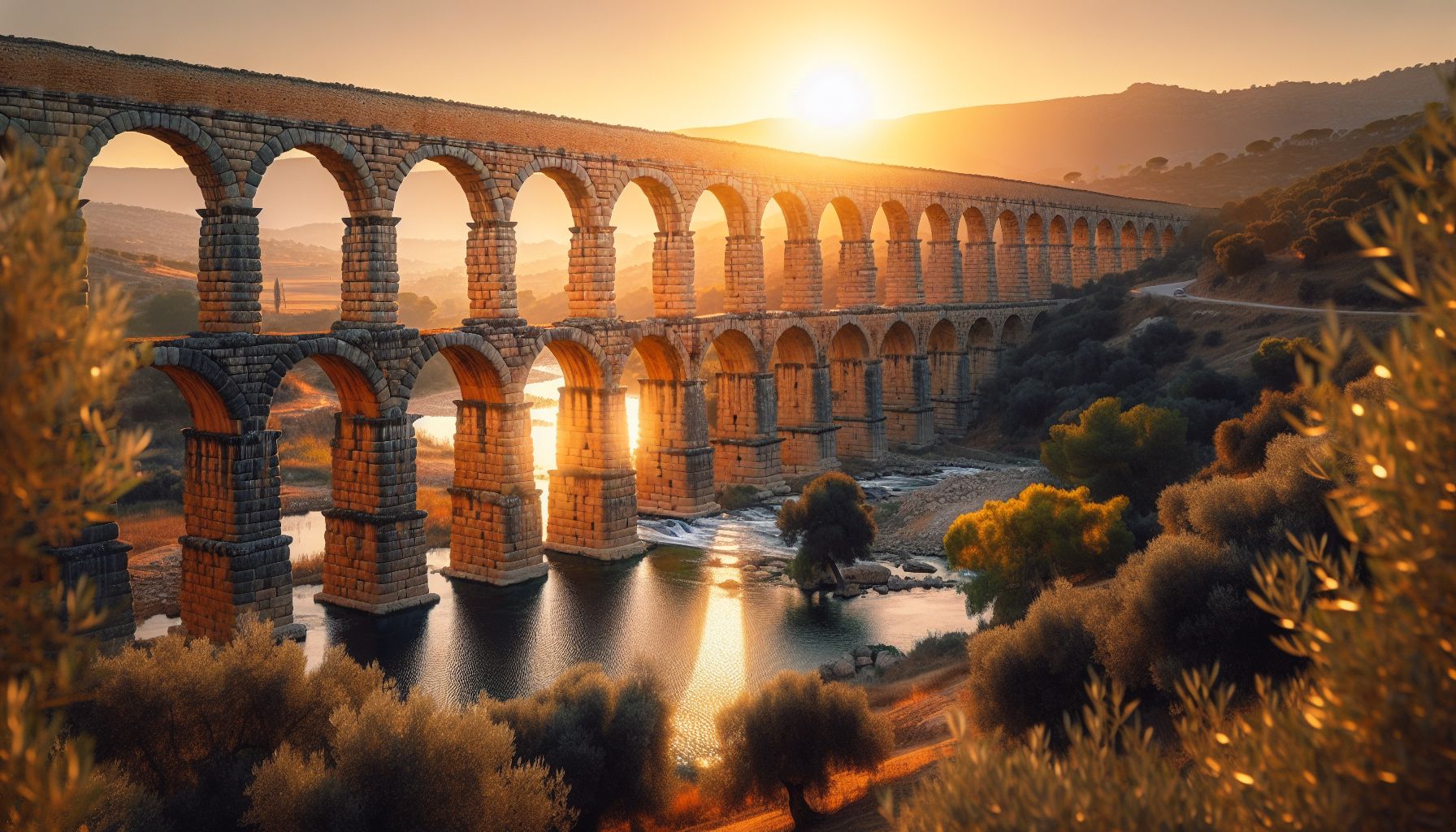
The aqueduct system of ancient Rome represents one of the earliest instances of utilizing groundwater to support human civilization. Their conduits, typically constructed from:
- stone
- brick
- concrete
- lead
The system transported water solely through the force of gravity, allowing water to carry water along a gentle downward slope within channels near the Gard River.
These conduits were typically flat-bottomed, arch-section conduits, with internal dimensions of approximately 0.7 m (2.3 ft) in width and 1.5 m (5 ft) in height. These dimensions were integral to maintaining a steady water flow, with lead pipes occasionally incorporated into the design. The volume of water transported within the conduit was affected by various factors. These include catchment hydrology, such as rainfall, absorption, and runoff, as well as the conduit’s cross section and gradient.
The Role of Gravity
Gravity was a key factor in the design of Roman aqueducts. The structure needed to start at a high elevation and descend, allowing gravity to naturally move the water without mechanical assistance. This process converted the water’s potential energy into kinetic energy.
To maintain a uniform water flow, Roman engineers designed aqueducts with the following features:
- A gentle downward incline from the source to the destination, utilizing gravity for propulsion
- Bypassing obstructing peaks in aqueduct construction to preserve the essential slope for efficient operation of gravity
- Excavating through obstructing peaks in certain instances, as needed
These design elements ensured the efficient and effective transportation of water through the aqueduct system.
Arches and Support Structures
Aqueducts were elevated above ground using arches and support structures, which allowed them to cross valleys while maintaining a consistent gradient for water flow. Among the many aqueducts in Rome, the Pont du Gard serves as a notable example, showcasing the effective use of multiple piered arches of masonry to support the water conduit.
Inverted siphons served the purpose of crossing deep or lengthy depressions when arches were not appropriate. They were constructed using soldered lead, and Vitruvius observed issues related to blockage, blow-outs, and venting caused by the high pressures at their lowest points.
In hilly terrains, Roman engineers utilized a combination of arcades, plain conduits buried at ground level, and large tunnels that could accommodate the conduit and maintenance workers.
Water Sources and Distribution
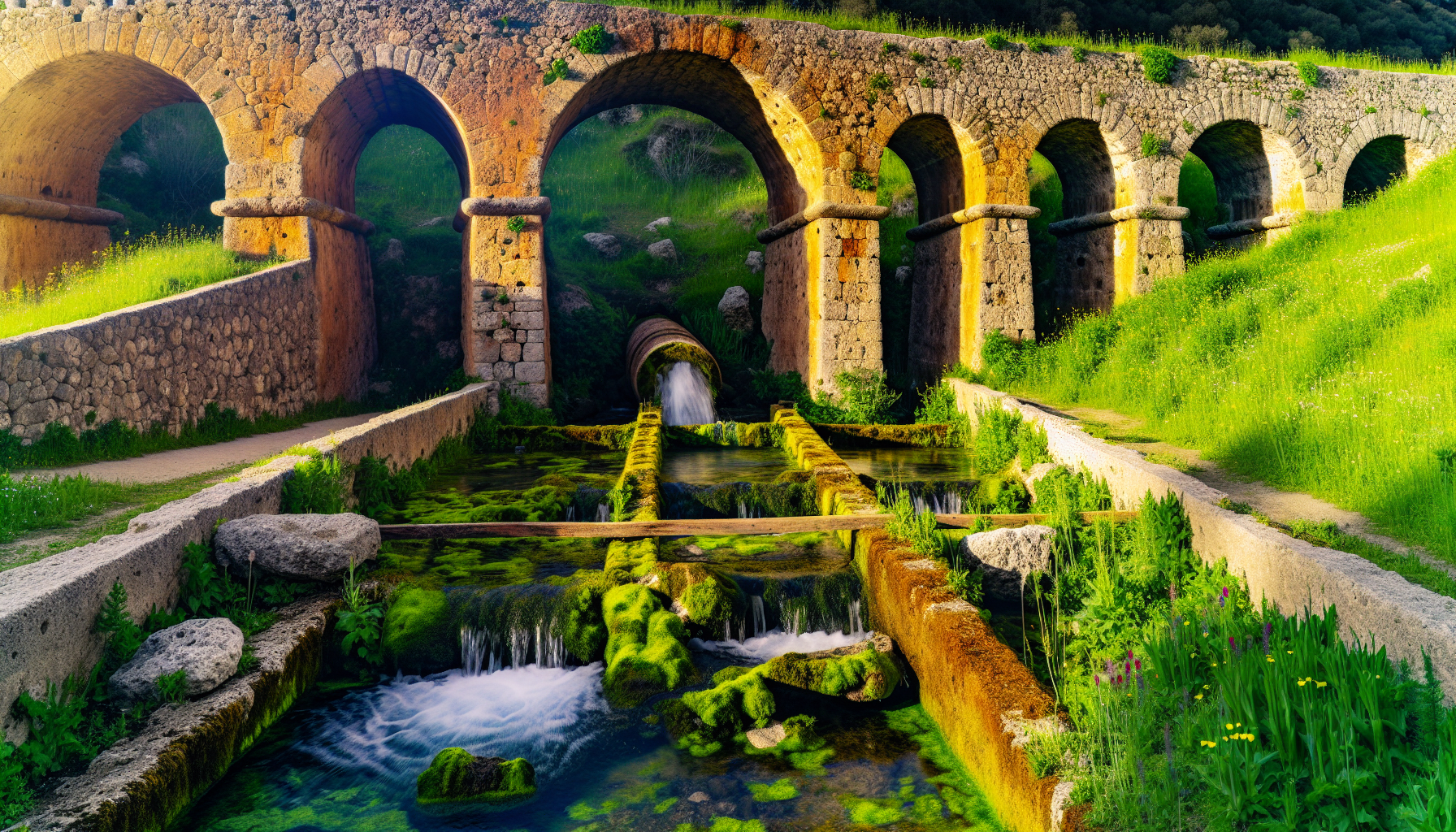
Springs were the predominant sources of water for Roman aqueducts. Vitruvius emphasized the significance of maintaining a consistent water supply and detailed the techniques for surveying and examining the quality of water in his work De architectura. The distribution of water from Roman aqueducts was carried out through castellum aquae, which served as settling tanks and cisterns for different branches. Private users who had the means to afford running water paid for the service according to the diameter of their access pipe.
Roman engineers ensured a consistent and suitable flow rate for the water over the entire distance by conducting extensive surveys of the territory.
Springs, Rivers, and Wells
The Romans chose water sources for their aqueducts based on their proximity to the cities or towns in need of water, giving priority to sources that provided clean and plentiful water. Among the water sources, springs were often favored due to their cleanliness and freshness, with a significant portion of Rome’s water supply coming from various springs in the Anio valley and its uplands.
The Romans maintained the cleanliness of water from selected sources by diverting clean rivers into separate channels with dams, treating drinking water, and regularly replacing the water in baths to maintain its purity. Engineers utilized gravity-powered systems, constructed underground pipes and tunnels, and established intakes with siphons as needed to transport water to Roman aqueducts, taking advantage of natural flow to maintain a consistent water supply.
Prioritizing Public Needs
The public needs were given priority in the allocation of water, ensuring that public basins, drinking fountains, and baths received water before private users. The provision of free, potable water to the general public in ancient Rome was considered one of the many gifts bestowed upon the people of Rome by their emperor, funded either by the emperor himself or by the state.
Public baths and fountains in Rome evolved into significant social hubs. Marcus Agrippa either built or financially supported the construction of 170 public bath-houses during his tenure, and a nominal fee was levied on each bather, on behalf of the Roman people.
Maintenance and Management of Roman Aqueducts
To ensure proper functioning, Roman aqueducts needed consistent and thorough maintenance. Regular upkeep was vital to maintaining their condition. Inspection and access points were strategically placed at regular intervals to facilitate investigation of suspected blockages or leaks with minimal disruption of the supply. The aquarii were a specialized group of workers tasked with the responsibility of ensuring the cleanliness and efficient functioning of Roman aqueducts. Their duties included conducting repairs, cleaning the channels to prevent blockages, and preserving the quality of water.
During the Republican era, the planning, construction, and management of aqueducts were carried out under the authority of the censors, or in the absence of a censor, the aediles. In the Imperial era, the emperors assumed lifelong responsibility for water supplies. Furthermore, in 97 AD under the emperor Nerva, Frontinus held the positions of consul and curator aquarum, indicating significant oversight and management of the aqueducts during the Imperial era.
Inspection Points and Leak Detection
Roman aqueducts were designed with inspection points to identify leaks and blockages, thereby ensuring the ongoing efficiency and functionality of the system. The Romans employed fundamental surveying techniques and the groma, a specialized tool, to inspect for leaks at the inspection points along the aqueducts.
Regular inspections were conducted on their aqueducts for leaks and blockages at consistent intervals, with manholes or inspection shafts placed approximately every 230 feet along the aqueducts. The Romans encountered difficulties such as:
- blockages
- blow-outs
- venting in siphons caused by high pressure at lower levels
- the frequent need to replace pipes due to the accumulation of calcium carbonate.
The Familia Aquarum
During the reign of Emperor Claudius, the Familia Aquarum was formed as a group of workers responsible for maintaining the imperial aqueducts in the City of Rome. It comprised 460 individuals, including both slaves and free citizens. The Familia Aquarum was funded through a combination of Imperial largesse and water fees paid by private subscribers.
The Familia Aquarum comprised:
- Overseers
- Reservoir keepers
- Linewalkers
- Pavers
- Plasterers
- Other workmen
They were under the supervision of an Imperial freeman, who held the title procurator aquarium, and was responsible for overseeing the maintenance and management of the aqueducts.
The Impact of Aqueducts on Roman Society
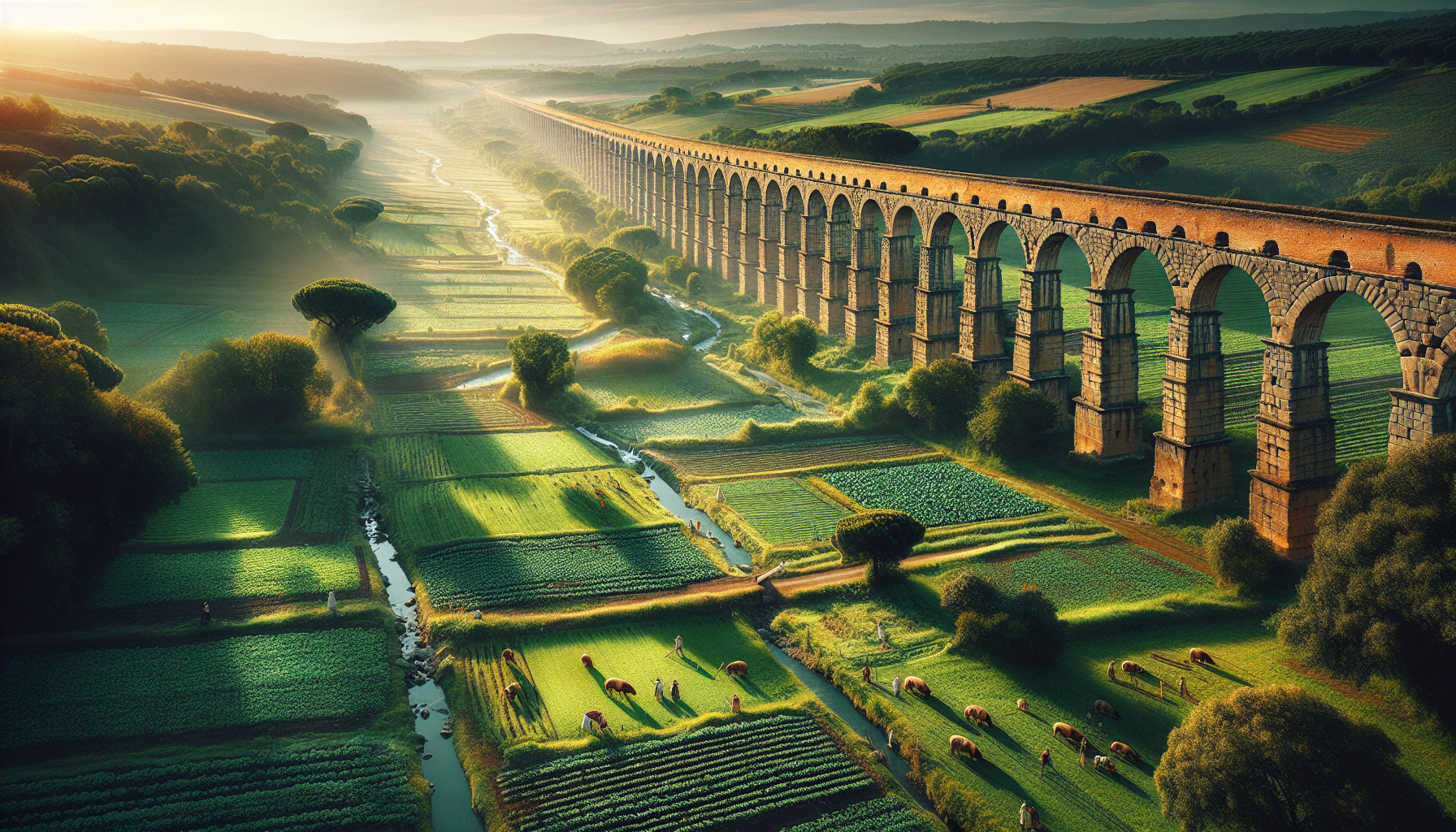
Aqueducts were vital to Rome’s agricultural economy, especially for irrigation. The dependable water supply they provided was crucial for irrigating farmland and cultivating diverse crops. Aqueducts were indispensable in supplying consistent water, vital for various industrial operations, including mining, milling, and machinery operation. This facilitated more effective production processes and contributed to the expansion of industries in Roman society.
Roman aqueducts significantly advanced public health and sanitation. They provided clean water supply for urban areas, aiding in the establishment of communal bathing facilities, water closets, and drainage systems, thereby promoting cleanliness and reducing waterborne illnesses within the community.
Farming and Irrigation
Roman aqueducts contributed to the enhancement of agricultural productivity by providing a dependable water supply for irrigation. This enabled the irrigation of crops outside of the cities, which in turn led to the development of improved farming techniques and an increase in output to meet the needs of the growing population.
Farmers residing near public aqueducts took measures to extract a specified amount of supply water for irrigation at scheduled intervals, often with official authorization, by utilizing a bucket inserted into the conduit through inspection hatches to effectively manage the water supply. The consistent water supply from the aqueducts enabled Roman farmers to cultivate a wider range of crops throughout the year, leading to enhanced crop yields and greater diversification of their agricultural methods.
Utilizing water from the aqueducts, a wide variety of crops were cultivated by farmers, including essential staples like wheat and barley, as well as fruits such as olives and grapes, which held significant importance in the Roman diet and economy.
Industrial Uses
Aqueducts played a crucial role in supplying water to mining sites for various processes, including hydraulic mining, hushing, and powering machinery such as water-wheel driven stamps and trip-hammers. Hydraulic mining and hushing were mining methods that utilized water for mineral extraction and debris removal to expose mineral deposits, respectively. Aqueducts played a crucial role in supplying the substantial amounts of water needed for these processes, significantly enhancing the efficiency of mining operations in ancient Rome.
The operational mechanism of water-wheel driven stamps and trip-hammers involved:
- Harnessing the flow or fall of water provided by aqueducts to power the machinery
- Transferring this motion to stamps or trip-hammers
- Crushing the extracted ore
- Facilitating further processing
Public Health and Sanitation
Providing clean water, the aqueducts of ancient Rome played a significant part in reducing water-borne diseases. They offered a reliable source of fresh water less likely to be contaminated with pathogens, thus decreasing the spread of diseases like malaria, intestinal diseases, and typhoid fever. Aqueducts contributed to the maintenance of sanitation in Rome by carrying away used water and waste, providing fresh water for public baths and toilets, and incorporating design elements like zigzags and covered sections to remove impurities and prevent contamination in the aqueduct systems.
Bathing held substantial social and cultural importance in Roman society, and aqueducts were instrumental in providing a dependable and ample water supply to public baths. This ensured a consistent flow of water and facilitated the enjoyment of bathing in a sanitary and hygienic setting. Prevalent water-borne diseases in Roman times consisted of malaria, intestinal diseases, and typhoid fever.
Aqueducts Beyond Rome
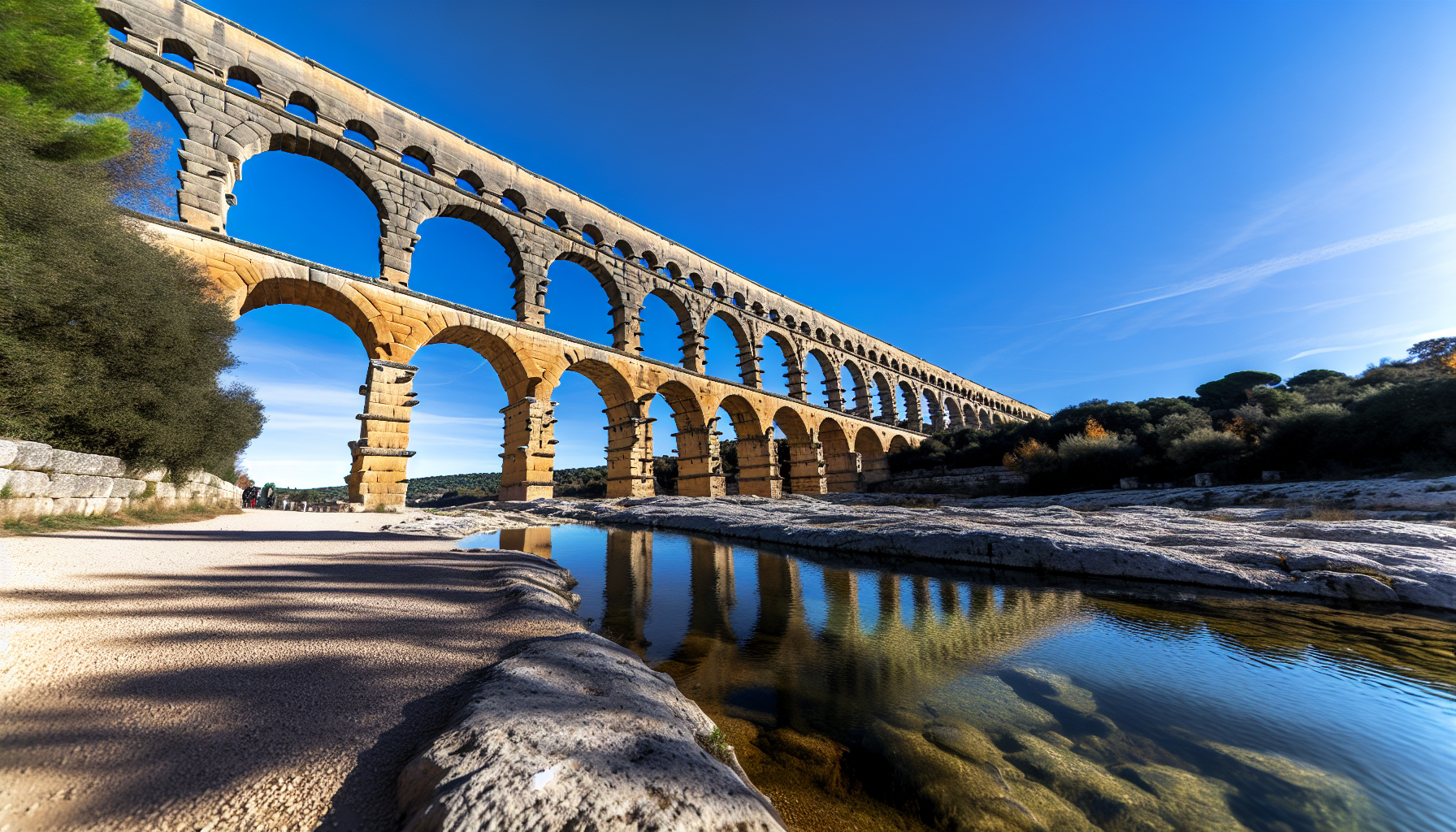
Some examples of intact Roman aqueducts located outside of Rome are the Pont du Gard in France and the Aqueduct of Segovia in Spain. The Pont du Gard, an aqueduct in Southern France, was built by the Roman Empire in 20 B.C.E., under the supervision of Marcus Agrippa. It played a vital role in ensuring a dependable water supply to the settlement of Nemausus (present-day Nîmes), highlighting its pivotal contribution to the local community.
The Pont du Gard, a remarkable structure in a Roman city, showcases the use of three tiers of arches, with the largest arch spanning 82 feet, demonstrating the sophisticated engineering expertise of the Romans.
The Segovia Aqueduct is remarkable for its:
- Substantial two arcades
- Built from unmortared granite blocks
- Withstood the test of time since the 1st century AD
- Showcasing the enduring strength and resilience of Roman engineering.
Pont du Gard in Southern France
The Pont du Gard is well-known for being:
- a first century A.D. Roman aqueduct in France
- crucial for delivering water over dozens of miles to the city of Nîmes
- constructed entirely without the use of mortar
- constructed using precisely cut stones that fit together without mortar
- some stones weigh as much as 6 tons, demonstrating the advanced masonry skills of the Romans.
The Pont du Gard aqueduct formed part of an approximately 50 km (31 mi) long system that supplied water to Nîmes. The Pont du Gard had the capability to transport up to 20,000 cubic metres of water daily, with a minimal gradient of only 34 cm per kilometer.
Segovia Aqueduct in Spain
The Aqueduct of Segovia is a Roman aqueduct located in Spain, believed to date back to approximately the second century A.D. It has the following principal architectural characteristics:
- It stands at a height of nearly 100 feet at its tallest bridge
- It underwent reconstruction in the 15th century, overseen by Queen Isabella
- It has remarkable double-tiered arches, which stand at a height of over 93 feet
- The reconstruction in the 15th century improved upon earlier designs by employing fewer arches of increased height, thereby enhancing the structural efficiency and material economy of the aqueduct.
The Segovia Aqueduct was constructed using thousands of granite blocks that were quarried from the nearby Guadarrama Mountains.
The Decline and Legacy of Roman Aqueducts
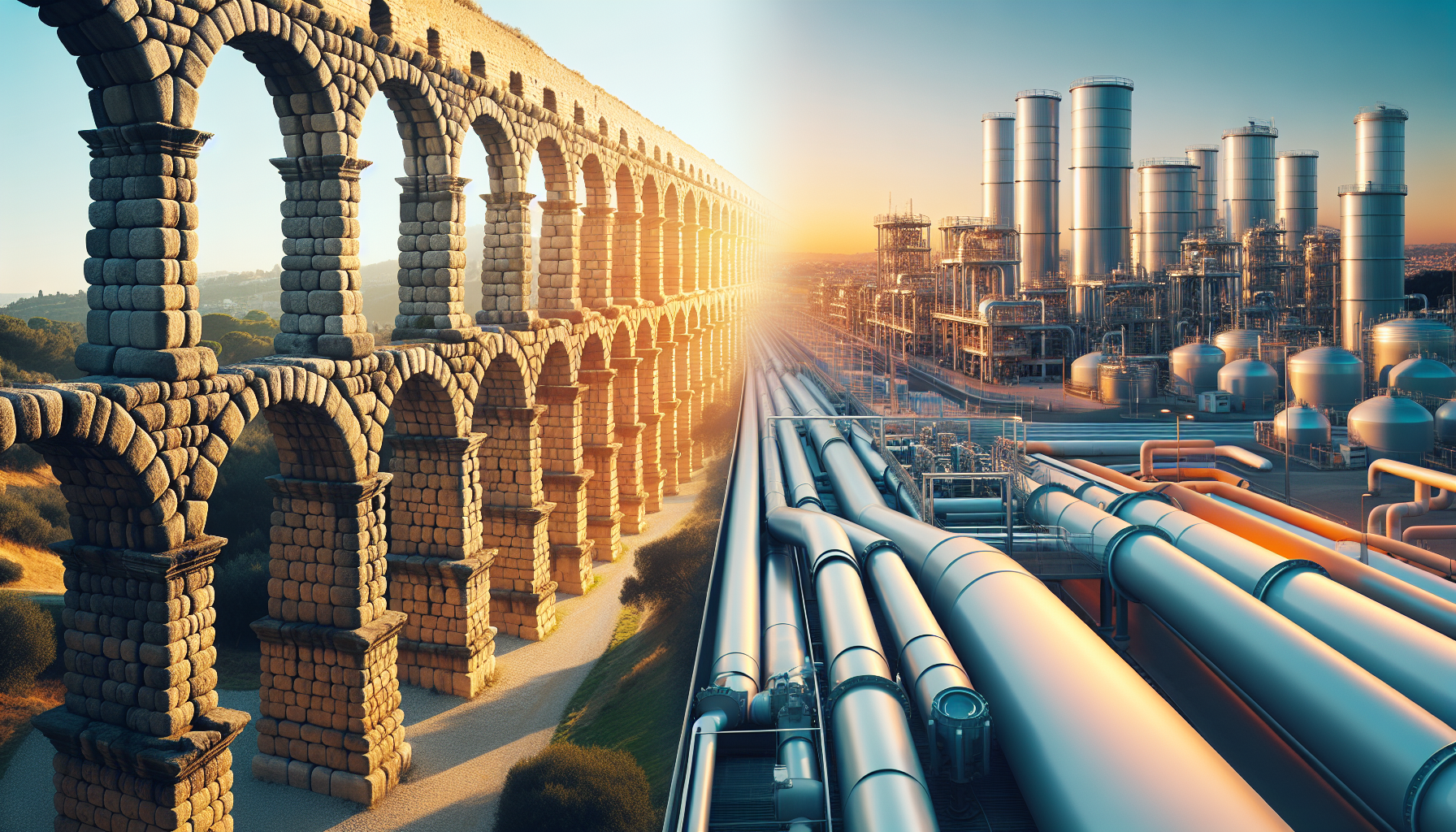
Most of the aqueducts deteriorated from lack of maintenance, leading to swamps and marshes forming at their damaged connections. By the late medieval period, only the Aqua Virgo remained as a reliable water source. The decline of Roman aqueducts resulted from the damage during the siege of Rome by the Goths and the subsequent destruction led by Roman general, Belisarius.
During the Renaissance, the remnants of aqueducts inspired architects and engineers, leading to renovations by figures like Pope Nicholas V, who restored the Roman Aqua Virgo in 1453, a significant achievement in the ancient world.
Fall of the Western Roman Empire
The decline of the Western Roman Empire, a significant part of the classical world, was attributed to a combination of factors including:
- Invasions by Barbarian tribes
- Economic challenges and excessive dependence on slave labor
- The emergence of the Eastern Empire
- Overexpansion
Following the decline of the Western Roman Empire, an important period in ancient history marked by the influence of Roman culture, the Roman aqueducts suffered deterioration, either through deliberate vandalism or disuse due to a lack of organized maintenance.
The decline of Roman aqueducts after the fall of the Western Roman Empire can be attributed to the collapse of centralized authority, economic decline, and a decrease in population and urbanization leading to reduced maintenance and abandonment. In certain areas, Roman aqueducts were utilized for extended periods, however, there was generally a deficiency in coordinated endeavors to uphold them, resulting in vandalism and neglect following the collapse of the Western Roman Empire.
Renaissance Revival and Modern Influence
In the Renaissance era, notable figures including Pope Nicholas V and Pope Paul V participated in the restoration and maintenance of Roman aqueducts. They, alongside other architects, engineers, and rulers, exerted substantial influence in the revival of these ancient water systems. Roman aqueducts had a significant influence on Renaissance architecture and engineering, inspiring the use of arches and construction techniques derived from ancient Roman practices, which contributed to the classic architectural revival and advancements in engineering.
The design principles of Roman aqueducts, particularly their utilization of gravity for long-distance water transportation and techniques such as underground pipes, have been incorporated into modern water distribution systems. This adaptation has contributed to improved water supply efficiency and enhanced sanitary conditions.
Summary
In conclusion, the Roman aqueducts were a marvel of engineering and a testament to the innovative spirit of the Romans. From their construction and maintenance to their impact on society and legacy, these structures were pivotal to the Roman civilization.
While the fall of the Western Roman Empire led to the decline of these magnificent structures, their influence lives on. Their ingenious design and functionality continue to inspire modern engineering and water management systems, proving that the legacy of Roman aqueducts goes beyond the realm of history and into the fabric of our contemporary society.
Frequently Asked Questions
What was the purpose of the aqueducts?
The purpose of the aqueducts was to transport fresh water to highly populated areas, such as ancient Rome.
Are aqueducts Greek or Roman?
Aqueducts were devised much earlier in Greece, but they are particularly associated with the Romans, who built a sophisticated aqueduct system to supply water to their cities.
Who invented the first aqueduct?
The first aqueduct, Aqua Appia, was erected in 312 BC by the censor Appius Claudius Caecus.
What are 3 facts about aqueducts?
Aqueducts required extensive planning, consisting of pipes, tunnels, canals, and bridges. They used gravity to channel water from a freshwater source to a city, and ancient aqueducts were built in various civilizations utilizing tunnels and depending on gravity for water flow (source).
Do any Roman aqueducts still carry water?
Yes, some Roman aqueducts, such as the Acqua Vergine, are still functioning and supplying water to parts of Rome today.
